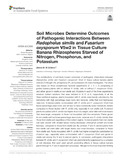Soil Microbes Determine Outcomes of Pathogenic Interactions Between Radopholus similis and Fusarium oxysporum V5w2 in Tissue Culture Banana Rhizospheres Starved of Nitrogen, Phosphorus, and Potassium
Abstract
The contributions of soil biota toward outcomes of pathogenic interactions between Radopholus similis and Fusarium oxysporum V5w2 in tissue culture banana plants starved of nitrogen (N), phosphorus (P), and potassium (K) were investigated. The study was based on three screenhouse factorial experiments (2 × 2 × 2) comprising of potted banana plants with or without R. similis, with or without F. oxysporum V5w2, and either grown in sterile or non-sterile soil. All plants in each of the three experiments received nutrient solutions that were deficient in N, P, or K, respectively. In all the three nutritional regimes, plants inoculated with R. similis were heavily colonized by the nematode with high percentage dead roots and necrosis, while their root biomasses were low. N-starved plants co-inoculated with R. similis and F. oxysporum V5w2 had lower percentage dead roots and tended to have numerically lower nematode density compared to those treated with R. similis only, especially in non-sterile soil. N-starved plants inoculated with R. similis had higher shoot dry weight, were taller with more leaves that were larger, compared to those not inoculated with the nematode. Plants grown in non-sterile soil had lower percentage dead roots, necrosis and R. similis density than those from sterile soil, regardless of the nutrient regime. N-starved plants from non-sterile soil were shorter with smaller leaves having decreased chlorophyll content and lower biomass, compared to those from sterile soil. By contrast, P and K starved plants from non-sterile soil were taller with larger leaves and more biomass, compared to those from sterile soil. Roots inoculated with R. similis had higher endophytic colonization by Fusarium spp., especially when co-inoculated with F. oxysporum V5w2 and grown in sterile soil among the N and K-starved plants. In conclusion, pathogenic interactions between R. similis and F. oxysporum V5w2 are predominantly suppressed by a complex of soil microbes that exert plant growth promoting effects in tissue culture banana plants through N, P, and K dependent processes. Nitrogen is the most important limiting factor in rhizosphere interactions between banana roots, beneficial microbes and the pathogens. Soil sterilization and the stringent aseptic tissue culture techniques still require the development of alternative innovative ways of conserving microbial services for sustainable agriculture.
URI
https://doi.org/10.3389/fsufs.2022.706072https://www.frontiersin.org/articles/10.3389/fsufs.2022.706072/full
http://ir-library.mmust.ac.ke:8080/xmlui/handle/123456789/2033
Collections
- Gold Collection [1005]

